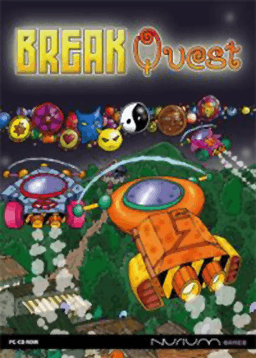BreakQuest
| BreakQuest | |
|---|---|
 Windows boxart | |
| Developer(s) | Nurium Games, Beatshapers (PlayStation Minis) |
| Publisher(s) | Stardock Nurium Games Red Marble Games Beatshapers (PlayStation Minis) |
| Platform(s) | Microsoft Windows, Mac OS X, PlayStation Portable |
| Release date(s) | Windows: November 15, 2004 Mac OS X: July 4, 2005 PlayStation Network: October 1, 2009 (EU) March 18, 2010 (NA) |
| Genre(s) | Action |
| Mode(s) | Single player |
BreakQuest is a multi-platform Breakout-style game created by Nurium Games, later ported to Mac OS by Red Marble Games. It was released on November 16, 2004, and was published by Stardock as part of TotalGaming.net. PSP Minis version developed and published by Beatshapers released in Europe/Asia with PSP Go launch, October 1, 2009. It was later released in the North America region for PSP Go on March 18, 2010.[1]
2-D physics engine
The most unusual aspect of the game is the use of the DynaMo physics engine. The engine enables all the objects in a level to interact with each other in a simulated physics environment. This allows for much more interesting gameplay, as the blocks and other objects respond realistically to collisions with the ball and each other. In many levels, some blocks or objects hang on strings that spin or move when hit, or are otherwise mobile. Sometimes, this can become chaotic as dozens of blocks, balls, and objects fly around and bump into each other. The use of the physics engine makes the levels in BreakQuest very dynamic, as opposed to the static brick formations seen in traditional breakout levels.
Storyline
A huge corporation rules the world by making thousands of TV channels and shows for people to watch. Everyone becomes addicted, starting the destruction of human intelligence. The player has to put up a transmitter to stop the satellite signals and end the corporation's rule.
Gameplay
There are two modes of play: Arcade and Quest. Quest is basically a "campaign mode", where the levels are played in order, while in Arcade, the goal is to beat random levels as fast as possible.
Unlike most Arkanoid clones, BreakQuest includes some innovative features:
Power-Ups
BreakQuest incorporates some unique power-ups that, for example, change the shape of the ball or bumper, or making the bumper "drunk". Most of these make the game harder by making it more difficult to predict the movements of the ball. Many of the bumper transforming effects can be combined, resulting in a large number of possible bumper shapes.
Other unique power-ups include "weapon" power-ups, such as mines, which are delivered using the ball. When a mine power-up is active, any ball touching the players' bumper attaches a mine. The mine is deposited when the ball next touches something, and explodes shortly after.
Level Design
The 100 levels available in the game have each been designed with their own theme, realised with distinct sound and visual effects, also utilizing some features of the physics engine. Depending on what mode of difficulty the player picks, they will get a 'key' to permanently make the level available.
Gravitator
Another notable element in BreakQuest is the Gravitator, which can be used to attract any balls towards the bottom of the screen. With sufficient skill, it can be used to guide a ball towards a specific block. This alleviates the difficulty of hitting the last block in a level, a problem present in many breakout games. Unfortunately, since Gravitator attracts toward the screen bottom, not the ship itself, it cannot be used to curve a ball travelling perfectly vertically, such as the initial shot at the beginning of every level.
Reserve ball
A reserve ball is an extra ball that the player starts with for every life. If the main ball is lost, the reserve ball is released. The player also has the choice of manually releasing the reserve ball. It is possible to gain additional reserve balls by collecting power-ups.
PSP minis version
BreakQuest PlayStation mini version developed and published by Beatshapers, features some modifications (according to developer's interview): levels are modified to fit PSP widescreen resolution, some levels are simplified to make a game playable because of performance issues. Also custom editable Arcade mode also has been removed, only preset modes (Beginner, Minimal, Fast, Armageddon, etc.) left in PlayStation version.
See also
References
External links
| |||||||||||||||||
| ||||||||||||||||||||||||||||||||||||||||||||||||||||||||||||||||||||
